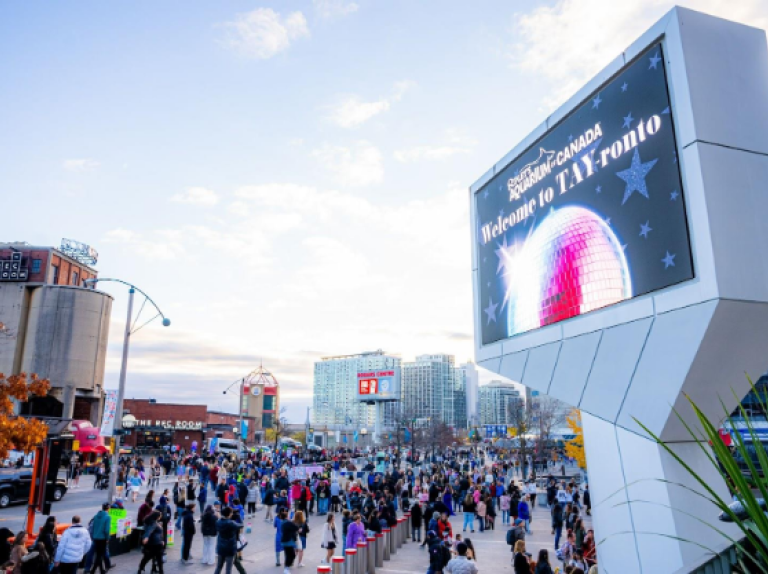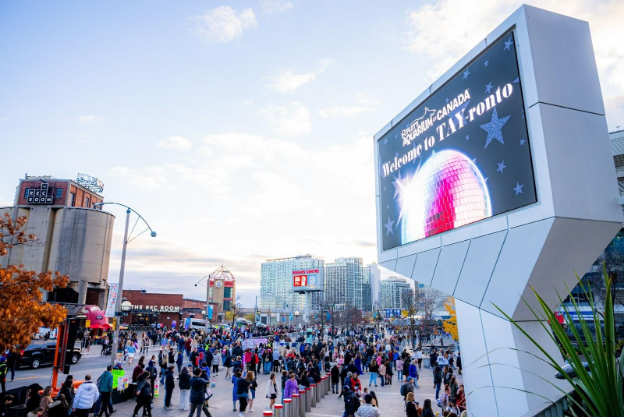
Destination Toronto has been utilizing the Event Impact Calculator since 2017 to calculate the impact of meetings, festivals, and sporting events. In November 2024, Taylor Swift's Eras Tour generated an estimated $282 million in total economic impact for Toronto across six shows, a significant impact during a time of the year that would typically be softer.
Destination Profile
Toronto’s visitor economy is a vital economic engine for the city, generating nearly $9 billion in visitor spending in 2024. Destination Toronto’s mandate is to reflect the breadth and diversity of Toronto’s people, places, and culture to inspire residents and visitors to meet, visit, and explore our city. Operating in partnership with the City of Toronto and the Greater Toronto Hotel Association, Destination Toronto markets and promotes the city to attract visitors and major meetings and events and supports local businesses to maximize the opportunities of the visitor economy.
Geographical Location
Toronto is Canada’s largest city, located in the province of Ontario and situated on the northwestern shore of Lake Ontario.
Destination Population Size
2.8 million
Organization Budget Size
$30-60 million CAD

Destination Challenge
Use a holistic approach to quantify the economic impact of the November 2024 Taylor Swift Eras Tour concert series, beyond standard performance metrics, to educate residents and stakeholders on the value of visitors.
Our Approach to the EIC
Destination Toronto uses the Event Impact Calculator (EIC) to demonstrate the value of the visitor economy. Visitor spending and economic impact data provide proof points for speaking to governments when advocating for support in attracting business events and destination improvements. Quarterly and annual economic impact reports are distributed to the tourism and hospitality community to support strategic sales and marketing deployment. Media relations strategies increase local awareness of the monetary value visitors bring to the destination. Our reporting to governments, stakeholders, media, and residents reflects local impact, including direct, indirect, and induced effects.
Our everyday use cases for the calculator are larger-scale meetings and conventions, where we report the total economic impact to our stakeholders beyond standard metrics. Toronto has a global influence across multiple economic sectors for business events, including technology, life sciences, finance, advanced manufacturing, and food and beverage. Our global sales team uses the calculator's outputs to enhance prospecting strategies to bring high-quality events to the city. In 2025, major meetings are projected to draw over 300,000 visitors to Toronto for business events, including the Alzheimer’s Association International Conference, the American Bar Association Annual Meeting, and the ACM SIGKDD International Conference for Knowledge Discovery and Data Mining. While the EIC is primarily used for larger meetings, we have utilized it for sporting events, including the 2024 NHL All-Star Weekend, and we have plans to use it for the FIFA World Cup 2026.
The Project
In November 2024, the Taylor Swift Eras Tour brought six shows to Toronto’s Rogers Centre over two weeks. Given the unprecedented interest and demand, the concert series provided a unique opportunity to leverage a global cultural moment to educate residents on the value of the visitor economy. Our business intelligence team started by reviewing the economic impact, visitation, and methodology from peer cities that had publicly shared economic impact data, to establish a baseline understanding of the event’s scale. However, as Toronto was one of only two Canadian cities to host the series, we anticipated some differences in visitation patterns. Through collaboration with local stakeholders and our peers in Vancouver, the other Canadian city host, we refined our input for the event impact calculator using estimates of ticket sales, accommodations, demand data, and documentation of themed events in Toronto to develop a more comprehensive measure framework based on early hotel booking trends. We calculated the scale of the event by measuring the impact of the individual shows and the surrounding events and bringing them together to capture a 360-degree view of the total economic impact.
For key metrics, we primarily focused on the impact of the revenue that came in and continued circulating in Toronto’s economy afterward. November was a key period for visitors to the city at a time when economic activity would normally be reduced. Visitors to the concert series participated in a wide range of Taylor-themed experiences that allowed them to explore the city’s neighborhoods and other attractions, resulting in increased induced economic impact. A key objective in our strategy was to help residents understand the link between large-scale events and the economic impact on locals who live, work, and play in Toronto.

Results & Key Performance Indicators
Our organization did not have a definitive goal for impact but instead focused on the calculator's outputs. In our calculations, we estimated that the visitors who came in for the concert would result in $152 million in direct impact and $282 million in indirect economic impact. The goal itself was not the numbers, but rather ensuring a rigorous, data-driven process of arriving at the numbers given the data at our disposal. Early and ongoing engagement with stakeholders and our host city counterparts in Vancouver helped stress-test and align our methodology, leading to more accurate and credible results.
“Our success was measured not by a specific number, but by being able to articulate the positive economic impact on residents, allowing us to demonstrate the visitor economy's value.” Destination Toronto
Once we reviewed the results with our stakeholders and peers, we felt confident in sharing the economic impact data externally. Following the media release, we saw messaging alignment from city stakeholders, government officials, and the media. Released figures regarding economic impact were picked up by media at a national level as well as by multiple publications in the US market.
Lessons Learned
The collaborative working group helped build credibility, refined the methodology, and created consistency in messaging. By proactively connecting with past host destinations and tapping into the Travel & Tourism Research Network in the US and Canada, we consolidated key learnings. Alignment with Vancouver, the only other Canadian city to host the Eras Tour, was essential to gaining national credibility. In sharing methodology with Vancouver, we aligned on goals and developed consistent economic impact estimates for the Canadian market, further validating the value of this type of reporting for major events
The economic impact of the six Toronto shows was reported outside of our local market. Syndicated stories in the Canadian Press were picked up by media outlets across the country, and publications in the United States such as The New York Times and Bloomberg also picked up the story, highlighting the demand for economic impact data for events that are tied to global cultural moments.
For future events of this scale, our organization will look at deploying a survey during the event to collect valuable insights from attendees. This will complement existing data for future large-scale events.
Actionable Advice
To ensure comparability of economic impact assessments, we recommend consistent methodology across peer cities as a benchmark. Additionally, a clear communication method enhances understanding and allows major events to be analyzed and presented from a broader economic perspective. The accuracy of results depends on the quality of the input data. Assumptions should reflect each destination’s unique realities by incorporating local data and models to maintain relevance while supporting replicable research findings.
The Event Impact Calculator is a great tool for destinations looking to quantify the benefits of hosting major events, conventions, business meetings, and leisure events for the local community. For events such as the Eras Tour concert series, including aligned smaller events that take place throughout the city can help demonstrate citywide impact. Additionally, we recommend using a multi layered approach to model different event categories and periods separately. Following data compilation, aggregating the results provides a clearer assessment of the event’s true impact. Focus on the details, develop a data-driven approach to estimating inputs, and draw learnings from similar past events and peer destinations to continually refine estimates.
We released Toronto’s economic impact estimates to local media about a month out from the concert series. By announcing these impacts in advance, there was more time to engage with local audiences and help curate the narrative of positive economic impact.
Key Takeaways
- Methodologies should incorporate best-practice models, local data, and destination-specific assumptions, aggregated to calculate the event’s true impact
- Collaboration with local stakeholders and host-city peers helped stress-test and refine our methodology, leading to more accurate and credible results.
- Media coverage outside of the local market highlighted the demand for economic impact data for events that are tied to global cultural moments.
Toronto, Ontario
Toronto is Canada’s largest city, located in the province of Ontario and situated on the northwestern shore of Lake Ontario.



